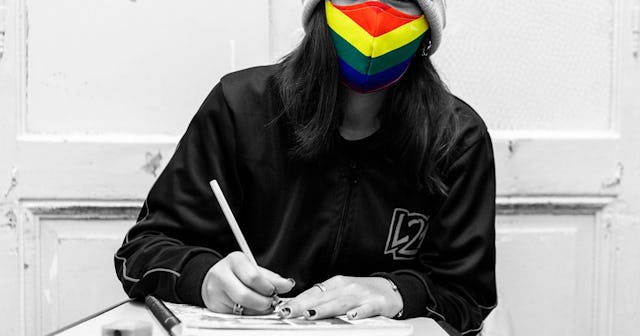For Queer Kids, School Has An Extra Layer Of Uncertainty This Year

Back-to-school looks a lot different this year. And by different I mean inequitable, scary, stressful, unpredictable, and exhausting. From the dumpster fire districts with all day, all week, masks optional, in-person classes to full-time virtual learning environments, students are expected to be in school in some capacity. No matter where school takes place, I am hoping teachers will remain anchors for our kids. The situation is new and scenarios are likely to shift, but kids’ teachers, as long as they stay healthy (and what an awful sacrifice and ask of our educators) will remain constant throughout the school year. I know teachers have too much on their plates right now, but one element that must remain is the need to protect queer students. If kids are expected to be in some version of school, they should also expect that their learning space is affirming and LGBTQIA+ inclusive.
The Trevor Project’s 2020 National Survey on LGBTQ Mental Health continues to show rates for depression, anxiety, self-harm, suicide ideation, and suicide attempts is disproportionately higher in the queer community, specifically among LGBTQ youth, compared to heterosexual cisgender peers. 40% of the 40,000 LGBTQ respondents ages 13-24 said they seriously considered attempting suicide in the past year; more than half of transgender and nonbinary youth seriously considered suicide. 68% of LGBTQ youth reported having anxiety within the past two weeks, including 74% of transgender and nonbinary youth.
Now imagine carrying those statistics in your backpack while you try to navigate the “normal” stress that comes with school and being a tween or teenager. Imagine the extra weight of navigating a pandemic when you’re constantly unsure of where or when you will receive support or rejection just because of your identity. It’s too much to carry.
I have always asked for a little extra from teachers and a lot more from their administrators when it comes to making sure all kids in their classrooms know they are in a LGBTQIA+ inclusive and safe space. I was once a closeted queer kid in school and know the damage of hearing negative and threatening homophobic rhetoric bounce off of silent teachers. I have a transgender daughter and know the risks for transgender students inside of schools. From harassment to assault, schools are one of the most common places for transgender youth to be denied the right to use the bathroom that matches their gender identity, to have their pronouns disrespected, and to be afraid of physical harm. If not in a physical classroom, queer kids are still fearful of cyberbullying and being misgendered by classmates and teachers.
Imagesbybarbara/Getty
I was recently in a Zoom meeting and despite the fact that my pronouns were next to my name and that I had stated that I use they/them pronouns, the facilitator still misgendered me. In one instance, she did it several times when talking about me in the third person to another person also attending the meeting. At first I waited for her to correct herself, then I zoned out, then I realized I had no idea what she was saying anymore. I interrupted her and said, “I’m sorry but I stopped listening. You keep misgendering me and I lost all focus. Please start over with my correct pronouns.” She apologized and did as I requested. Even though I wished I didn’t need to make that statement, I was confident that it would be well-received and that made it easier to speak up.
Most students will not have the emotional ability or airtime to speak up for themselves. They may not have allies who will either. And not all teachers will respect students when they are corrected. Many teachers avoid allyship because they feel uncomfortable or uninformed or they won’t support queer kids because it is against their own beliefs. Neither reason is acceptable.
Students—regardless of sexual orientation, gender identity, or gender expression—should expect safe and inclusive learning spaces. Even in the middle of a pandemic. So much focus is rightfully being placed on how to educate our kids through curriculum that will be offered online and with strict social distancing if kids are in the classrooms where science trumps opinion. It’s going to be hard to teach math while also trying to remind students to keep on their masks, wash their hands, and keep supplies to themselves. It may seem hard or even unnecessary to focus on inclusive language, pronouns, and allyship but we can’t forget about the queer students.
Kids are resilient and new habits will be made while students adjust to the creative solutions our teachers and schools come up with to keep our kids socially, emotionally, and intellectually engaged. But a large part of feeling emotionally safe for queer kids is having at least one person in their lives who is supportive and affirming. LGBTQIA+ youth who have that support are less likely to attempt suicide. Suicide rates also decrease when transgender and nonbinary youth have their pronouns respected. 25% of LGBTQ youth used pronouns other than he/him or she/her pronouns, yet The Trevor Project’s 2020 National Survey on LGBTQ Mental Health reports that less than 1 in 10 nonbinary youth have their pronouns respected by all people in their lives.
Best practices in school classrooms—whether in person or via virtual tools—need to include mindfulness in the use of a student’s requested name and pronouns. It’s important that teachers keep fighting the urge to use gendered language while constantly challenging gender stereotypes. Visible signs of allyship are necessary in curriculum, books, and physical spaces. Teachers may be a student’s only positive outlet, and if a queer student is still stuck at home with unaccepting caregivers for the foreseeable pandemic-themed future, they have the honor to be a literal lifeline.
This article was originally published on